Renoir, Impressionism, and Full-Length Painting
February 7 through May 13, 2012
Checklist
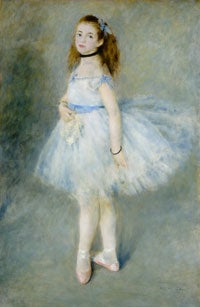 |
|
Pierre-Auguste Renoir (1841–1919)
The Dancer
1874
Oil on canvas
National Gallery of Art, Washington, D.C.
|
|
Renoir's ballerina is a young dancer in the Paris Opera shown
posing on the diagonal floorboards of the practice room,
her tutu flaring up behind her. She assumes the ballet's fifth
position, in which both feet cross each other, as we see here.
Renoir's bright palette and energetic brushwork, so familiar
to us today, struck his contemporaries as audacious. The girl's
neck, clavicle, and shoulder are modeled in blue; her flesh
tones are inflected throughout with touches of blue, green,
and yellow. Despite the speed with which he worked, Renoir
was attentive to details such as the black velvet choker that
encircles the dancer's neck and the blue jeweled gold bracelet
on her right wrist. He even suggests the tightness of the silk
ribbons of the ballerina's new pink slippers.
 Return to top Return to top
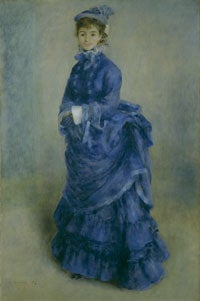 |
|
Pierre-Auguste Renoir (1841–1919)
La Parisienne
1874
Oil on canvas
National Museum Wales, Cardiff |
Renoir presents his pert subject dressed from head to foot
in an outdoor morning toilette of striking blue silk, with
matching toque and choker, appropriate for the spring. This
Parisienne's walking dress consists of a jacket worn over a
double-layer skirt, with the overskirt pulled into a bustle
in the back and the underskirt trimmed at the front with
two pleated flounces. Initially, Renoir may have intended to
present his model in a more defined setting, since he appears
to have laid in background elements such as a doorway or
column at left. Although this is not a portrait, we know that
Renoir used the services of his favorite model at the time,
Marie-Henriette Grossin, a seventeen-year-old actress who
would later assume the stage name Madame Henriot. She
posed for two other pictures in this exhibition: Madame
Henriot "en travesti'' (The Page) and La Promenade.
 Return to top Return to top
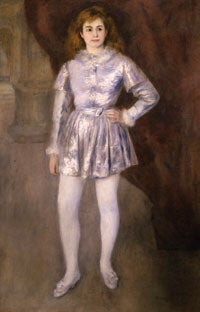 |
|
Pierre-Auguste Renoir (1841–1919)
Madame Henriot "en travesti" (The Page)
1875–76
Oil on canvas
Columbus Museum of Art, Ohio |
Renoir's eighteen-year-old model, Marie-Henriette Grossin — an actress who later adopted the stage name Madame
Henriot — appears before a red velvet curtain, with a glimpse
of the theater behind her. She is playing a boy's role, as we can
see from her costume, and wears a long-sleeved doublet with
buttons fastened tightly down the center, reminiscent of
a troubadour. Eager to make his mark as a painter of
theatrical celebrities, Renoir may have posed Henriot as the
beautiful page Urbain, who serves Queen Marguerite de
Valois in Les Huguenots, an immensely popular opera set in
the sixteenth century. Henriot had no training as a singer and
could never have appeared in this opera; she was performing
supporting roles in one of Paris's minor theaters at the time.
 Return to top Return to top
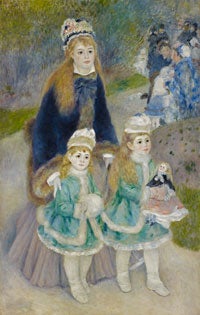 |
|
Pierre-Auguste Renoir (1841–1919)
La Promenade
1875–76
Oil on canvas
The Frick Collection, New York |
A young woman shepherds a pair of identically dressed little
sisters along the path of a well-maintained public park. All
three figures are outfitted for the cold and in the height of
fashion. The eldest wears a blue velvet jacket with wide
sleeves trimmed with red fox; the little girls wear miniature
blue-green jackets trimmed with either swansdown or
white mink. Further up the pathway to the right, Renoir
has included no fewer than eleven additional figures and
two playful dogs. La Promenade was the centerpiece of the
artist's submission to the Second Impressionist Exhibition in
the spring of 1876. To his dismay, most critics ignored this
ambitious figure painting and those who commented on it did
so unfavorably.
 Return to top Return to top
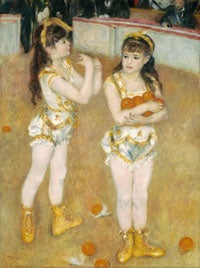 |
|
Pierre-Auguste Renoir (1841–1919)
Acrobats at the Cirque Fernando
(Francisca and Angelina Wartenberg)
1879
Oil on canvas
The Art Institute of Chicago |
Seen from above, but up close — as if observed through
opera glasses from one of the cheaper seats — Renoir's
young circus girls are shown receiving applause at the
end of a performance. The older girl at left takes her bow
while her sister holds five of the oranges offered as tribute.
It was customary for the best performances in the circus
to be recognized by a flood of oranges, often thrown by
appreciative children in the audience. Renoir lightly applies
his paint in thin, translucent washes. He models the girls' skin
tones in Naples yellow and outlines their arms and legs in
violet. Renoir's models at this circus in Montmartre were most
likely Francisca and Angelina Wartenberg, aged seventeen and
fourteen, respectively, who were part of an itinerant German
acrobatic troupe.
 Return to top Return to top
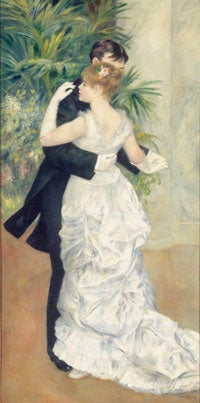 |
|
Pierre-Auguste Renoir (1841–1919)
Dance in the City
1883
Oil on canvas
Musée d'Orsay, Paris |
A young couple waltz alone on an immaculate parquet
floor in a marble salon, with palms and indoor plants behind
them. The woman, her hair in a chignon adorned with a single
pink rose, is wearing a "toilette de bal" of white satin or silk
taffeta, with organza, lace, or chiffon trimming around the
neck and shoulders of the bodice. Her neck and back are most
likely powdered, and she wears elbow-length white gloves of
satin or leather, an essential accouterment for her sleeveless
ball gown. Here Renoir used two of his friends as models.
The demure, well-bred young woman was posed for by the
eighteen-year-old artist and habituée of Montmartre, Suzanne
Valadon. Her partner was modeled for by the twenty-three-year-old journalist Paul Lhote, a man about town whose
handsome features Renoir faithfully recorded.
 Return to top Return to top
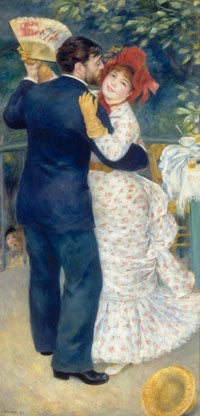 |
|
Pierre-Auguste Renoir (1841–1919)
Dance in the Country
1883
Oil on canvas
Musée d'Orsay, Paris |
Dance in the Country was painted as a companion to Dance
in the City. It shows
a couple dancing on the terrace of an outdoor restaurant.
They appear to have just left their table, which is covered
by a small tablecloth, napkins, a cup and spoon, and a half-filled
decanter and glass. Renoir's friend Paul Lhote posed
for the dancer in a dark woolen lounge suit; we see him
again in an elegant dresscoat with tails in Dance in the City.
The red-cheeked, smiling female dancer, more plump than
her counterpart in the latter picture, was modeled for by the
twenty-three-year-old Aline Charigot, Renoir's mistress of
three years, and later his wife.
 Return to top Return to top
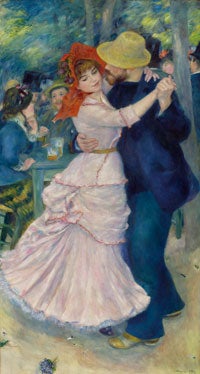 |
|
Pierre-Auguste Renoir (1841–1919)
Dance at Bougival
1883
Oil on canvas
Museum of Fine Arts, Boston |
Probably the last of these three Dance pictures to be
completed, Dance at Bougival is the most romantic of the
trilogy. Eyes masked by his boatman's straw hat, the male
partner expresses his intentions through body language that is
as legible today as it would have been a century and a quarter
ago. His female companion's willing compliance completes the
harmony, both visual and sensual, that is at the heart of this
painting. The touching of ungloved hands and the proximity
of the dancers' faces would have appeared audacious to a
late nineteenth-century audience. Like the companion Dance
pictures, Dance at Bougival achieves the luminosity of
Renoir's Impressionist work while maintaining the solidity
of modeling that characterized his most recent portraits
and figure paintings. The participants are shown enjoying
a Sunday afternoon ball at Bougival, a village ten miles west
of Paris with a somewhat dubious reputation.
 Return to top Return to top
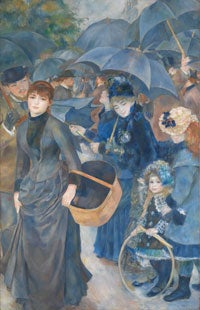 |
|
Pierre-Auguste Renoir (1841–1919)
The Umbrellas (Les Parapluies)
c. 1881–85
Oil on canvas
The National Gallery, London |
The Umbrellas was begun in 1881, abandoned that year,
and only returned to and completed in 1885. The figures in
the foreground on the right, executed in 1881, are painted
in the colorful palette and with the feathery handling of
Impressionism. We see an elegantly attired mother, leaning
forward slightly and accompanied by her two daughters, and
a well-dressed young woman behind her, about to open her
umbrella. Renoir's repainting of the canvas four years later
led him to rework the two figures on the left: the bare-headed
milliner's assistant, carrying her hat box, and the well-dressed
man who offers her the protection of his umbrella. It was only
at this later stage that Renoir painted the many supporting
figures in the background as well as all the umbrellas. By
the time The Umbrellas was finished, not only had female
fashions changed, but Renoir's style had also developed into
the more linear and muted handling associated with
his "Ingres" period.
 Return to top Return to top
Principal funding for the exhibition is provided by The Florence Gould Foundation and Michel David-Weill.
Additional support is generously provided by The Philip and Janice Levin Foundation, The Grand Marnier Foundation, and the Pierre and Tana Matisse Foundation.
Corporate support is provided by Fiduciary Trust Company International.
The exhibition is also supported by an indemnity from the Federal Council on the Arts and the Humanities. |


